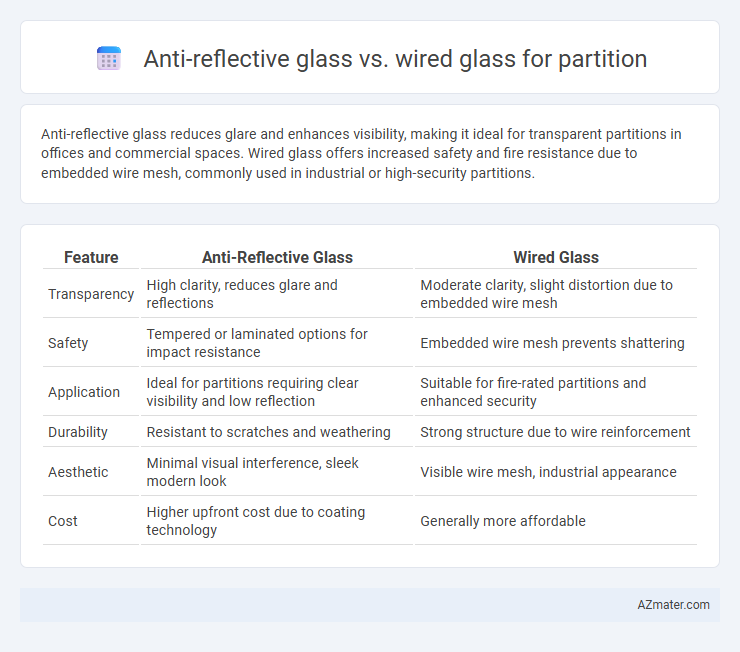Anti-reflective glass reduces glare and enhances visibility, making it ideal for transparent partitions in offices and commercial spaces. Wired glass offers increased safety and fire resistance due to embedded wire mesh, commonly used in industrial or high-security partitions.
Table of Comparison
| Feature | Anti-Reflective Glass | Wired Glass |
|---|---|---|
| Transparency | High clarity, reduces glare and reflections | Moderate clarity, slight distortion due to embedded wire mesh |
| Safety | Tempered or laminated options for impact resistance | Embedded wire mesh prevents shattering |
| Application | Ideal for partitions requiring clear visibility and low reflection | Suitable for fire-rated partitions and enhanced security |
| Durability | Resistant to scratches and weathering | Strong structure due to wire reinforcement |
| Aesthetic | Minimal visual interference, sleek modern look | Visible wire mesh, industrial appearance |
| Cost | Higher upfront cost due to coating technology | Generally more affordable |
Introduction to Glass Partitions
Glass partitions enhance office transparency and light flow, with anti-reflective glass offering superior clarity by minimizing glare and reflections, ideal for modern, visually open spaces. Wired glass provides added safety and fire resistance through embedded wire mesh, making it suitable for partitions requiring enhanced security and regulatory compliance. Choosing between anti-reflective and wired glass depends on the balance between aesthetic appeal and functional safety needs in partition design.
What is Anti-Reflective Glass?
Anti-reflective glass is specially coated to reduce glare and reflections, enhancing visual clarity and transparency for partitions in office or commercial spaces. This type of glass improves light transmission by minimizing surface reflections, making it ideal for environments requiring clear visibility and minimal distraction. Compared to wired glass, which is designed primarily for safety and fire resistance with embedded metal mesh, anti-reflective glass prioritizes optical performance and aesthetic appeal.
What is Wired Glass?
Wired glass is a type of safety glass embedded with a metal wire mesh that holds the glass together upon impact or breakage, enhancing fire resistance and security. It is commonly used in partitions to provide visibility while ensuring safety and preventing glass shattering hazards. Unlike anti-reflective glass, wired glass sacrifices optical clarity for strength and fire-rated performance in commercial and industrial spaces.
Aesthetic Differences: Clarity and Design
Anti-reflective glass for partitions offers superior clarity by minimizing glare and reflections, enhancing visual transparency and creating a sleek, modern aesthetic ideal for open, bright office spaces. Wired glass, characterized by embedded metal mesh, presents a more industrial look with a textured design that scatters light, reducing overall transparency and offering a distinctive, vintage or safety-focused appearance. The aesthetic difference centers on anti-reflective glass providing a clean, unobstructed view, while wired glass adds structural texture and a retro or utilitarian design element.
Light Transmission and Visual Comfort
Anti-reflective glass offers superior light transmission, typically allowing over 95% of natural light to pass through, enhancing visual comfort by reducing glare and reflections in partitions. Wired glass, while providing increased safety and fire resistance due to embedded wire mesh, generally has lower light transmission rates around 70-80%, which can cause a slight dimming effect and reduced visual clarity. For applications prioritizing maximum daylight and glare-free environments, anti-reflective glass is the optimal choice, whereas wired glass balances safety with moderate light diffusion.
Safety and Security Features
Anti-reflective glass enhances visibility and reduces glare, improving safety by minimizing visual distractions in partitioned spaces, while its laminated options provide impact resistance and shatter protection. Wired glass contains embedded wire mesh that maintains structural integrity during breakage, offering superior fire resistance and security against forced entry. Both types contribute to building safety, but wired glass is preferred for fire-rated partitions, and anti-reflective glass suits environments requiring clear sightlines and aesthetic clarity.
Acoustic Performance Comparison
Anti-reflective glass for partitions offers superior acoustic insulation due to its specialized coatings that reduce surface reflection and enhance sound absorption. Wired glass, while providing added safety through embedded wire mesh, typically exhibits lower acoustic performance as the mesh disrupts sound wave propagation. For environments prioritizing soundproofing, anti-reflective glass delivers more effective noise reduction compared to wired glass.
Durability and Maintenance Needs
Anti-reflective glass for partitions offers high durability with scratch-resistant coatings that maintain clarity while requiring minimal cleaning due to reduced glare and smudges. Wired glass provides robust safety features with embedded wire mesh that prevents shattering, but it tends to accumulate dirt in the mesh, increasing maintenance efforts. For long-term use, anti-reflective glass demands less upkeep and maintains aesthetic appeal better, whereas wired glass prioritizes enhanced protection but may require more frequent cleaning and inspection.
Cost Considerations
Anti-reflective glass typically incurs higher initial costs due to advanced coatings and manufacturing processes that reduce glare and improve clarity, making it a premium option for partitions. Wired glass, featuring embedded wire mesh for enhanced safety and fire resistance, generally offers a more budget-friendly price point but may compromise on aesthetic appeal and transparency. Evaluating long-term costs also involves considering maintenance, durability, and energy efficiency benefits associated with each glass type in partition applications.
Choosing the Right Glass for Your Partition
Selecting the right glass for your partition depends on factors such as visibility, durability, and safety requirements. Anti-reflective glass enhances transparency and reduces glare, making it ideal for settings requiring clear views and minimal light distortion. Wired glass offers superior fire resistance and added security due to embedded metal mesh, suitable for partitions in high-traffic or safety-critical areas.

Infographic: Anti-reflective glass vs Wired glass for Partition
 azmater.com
azmater.com